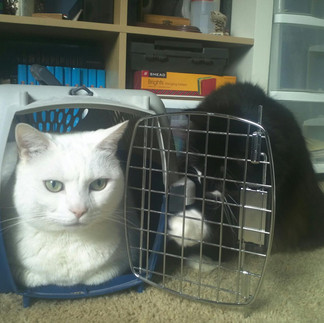Kittens, Carriers, and Cooperative Care
- jessica4485
- Feb 1, 2022
- 4 min read
Updated: Feb 1, 2022

Welcome to Cat Health Month, February 2022. We are excited to spend this month exploring essential tips for cat health through the four stages of our cats’ lives. This week we will start at the kitten stage.
This stage is the foundation for their life. It’s the time when you can expose your kitten to routine medical care in a safe, comfortable, controlled environment using positive reinforcement.
According to The American Association of Feline Practitioners, 83% of cats go to the vet before their first birthday. But, unfortunately, half of those don’t return until they are sick or in pain. So why don’t cat parents bring their cats to the vet? Most say it’s too stressful to get them into the carrier and then bring them to an unfamiliar environment.
Why does your cat need to go to the vet? Cat Friendly Homes provide a great list of reasons why here.

I genuinely believe our cat’s veterinarian is our partner in providing our cats with a long, healthy, and pain-free life. The key to cat health is taking your cat to the vet regularly. Regular vet visits allow for preventative care vs. reactive care. Preventive care allows you and your vet to spot a routine medical need before it turns into a crisis. The earlier you manage common feline diseases, the more comfortable your cat will be and the less impact it will have on your wallet. Preventive care gives you control vs. running to the ER at 3 am.
American Association of Feline Practitioners gives some great tips to help relieve the stress of getting your cat to the vet.

How can we make going to the vet less stressful for you and your cat? It starts at home:
Make their carriers a safe space.
Do practice vet exams at home using cooperative care during kittenhood and throughout their life.
Carriers
When I was fresh out of college, I had a two-year-old cat, Betty, and a five-month-old kitten, Leo. While living on the sixth floor, there was a fire in our building. As firefighters were pounding on the door to evacuate, I told the fireman I wasn't leaving without my cats. So I grabbed Betty holding her tight while the fireman stuffed Leo into a pillowcase. From that night on, carriers were part of every room in my home.
A few years later, I was in another much worse fire. Thankfully I had two carriers within feet of us, and the three of us got out quickly. I am very passionate about making sure carriers are out in the home, visible and accessible. They saved our lives.
Not only should carriers be out for safety, but also for the comfort of your cat. Both Eddy and Libby love their carriers. It’s a spot for them to curl up and take a blissful nap without another cat pouncing on them. Then, when it’s time to head to the vet, their carriers are out with their favorite bedding and smells. They go right in, knowing this is their safe spot.
Here are a few more great resources about cat carriers that can be found on catfriendly.com.
What is cooperative care?
Chirrups and Chatter provides a wonderful video about what cooperative care is and what it looks like. I highly recommend taking the time to watch this informative video.
Cooperative care is about establishing a communication system between you and your cat, working together to provide low-stress handling during medical exams and medication administration. You and your cat work together to say yes, I am comfortable moving forward with care or no, I need a break from being handled. It allows your cat to have a say in the care they are receiving while providing them with fear-free care.
How can we work toward cooperative care?
1. Incorporate clicker games into your daily routine with your cat. You can get started by downloading our handout "Cat clicker games, a free guide to getting started." For example, click here to see a video demonstrating a kitten getting comfortable with being handled using clicker games.
2. Cooperative care starts at home by practicing physical exams with your cat. First, create a "care center" at home. This should be a place your cat is comfortable going to on their own. It should be a place they have positive feelings towards. In this video, Dr. Sally Foote provides information on "How to create a cat home care center."
Preparing for a vet visit starts in your home well before the first visit. Using these resources will allow your cat to create a positive association with the carrier and low-stress handling during the vet visit. In addition, by taking these steps during kittenhood, you are setting yourself and your cat up for lifelong success. The result will ensure that your cat gets preventive care for a lifetime ahead.

Where do you keep your carriers? After reading and watching more about cat carriers, will you make your carriers part of your everyday living? Next week, we discuss the Young Adult life stage of cats. Comment below with your thoughts and questions.
















Comments